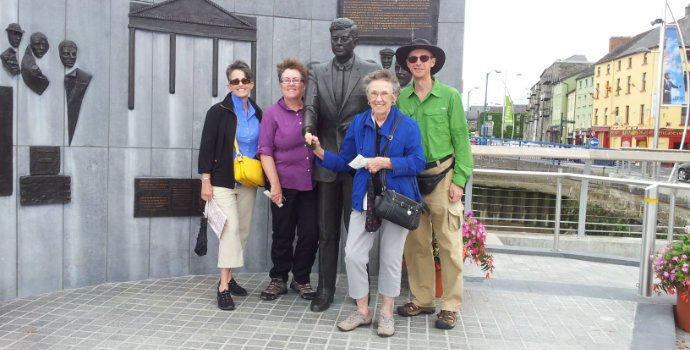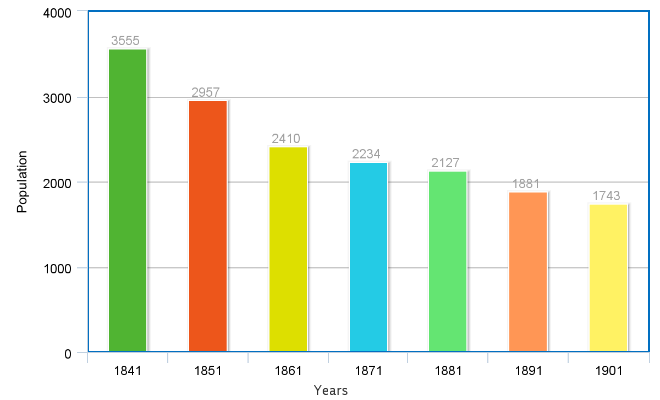
St Mullins, like all Irish communities, has a wide diaspora spread throughout the world, and particularly in the USA, Australia, New Zealand, and the UK.
For many of these, sense of place is extremely important. All Irish people have a keen sense of attachment to their place of origin. For many Irish people abroad, it is not just a question of being from Ireland, but which county, town, or even townsland a person is from. This attachment to place can be passed down through the generations.
In recent years, a number of initiatives in Ireland have brought home the effectiveness of building on that sense of place. In 2013, The St. Mullins Gathering was one of 5,000 Gatherings organised nationally to make connections globally.
Emigration and Population Decline
In common with the rest of Ireland, St Mullins experienced massive emigration and population decline beginning in the mid-19th century, as shown by Census figures from the time.
Population of Baronies of St. Mullins Lower and Upper 1821 – 1841
A barony is a historical subdivision of a county, similar to the hundreds into which the counties of England were divided. Baronies were created during the Tudor conquest of Ireland, replacing the earlier cantreds formed after the original Norman invasion. There are 52 townslands in the Barony of St. Mullins Lower.
| Census Year | Population | Houses |
|---|---|---|
| 1821 | 9,840 | 1,650 |
| 1831 | 10,160 | 1,675 |
| 1841 | 10,392 | 1,672 |
Persons 5 years old and upwards
| Who can read and write | 2,548 |
|---|---|
| Who can read only | 2,540 |
| Who can neither read nor write | 3,985 |
Most common surnames in St. Mullins in 1852/53
| Surname | Households |
|---|---|
| Murphy | 72 |
| Doyle | 46 |
| Ryan | 37 |
| Byrne | 24 |
| Kavanagh | 24 |
| Morrissey | 16 |
| Neill | 14 |
| Foley | 12 |
| Rourke | 12 |
| Bolger | 11 |
—
The figures above are taken from surviving indices to the 1821, 1831 and 1841 Censuses, which were largely destroyed in a fire in the public records Office in 1922 during the Irish Civil War.
Population in St. Mullins Civil Parish 1841 – 1901

Note the statistics in the graph refer to the Religious Parish of St Mullins, a different population division to which the Baronies for which the earlier figures applied.
The population of St Mullins today is 1,360 people in 360 houses, according to the most recent Census.
Tracing Your Roots
If your ancestor came from the St. Mullins or South Carlow area, or neighbouring parishes in Counties Wexford and Kilkenny, we can help you access the volume of records available on a particular family. All queries are answered. If we are unable to help, we will refer you to the appropriate source.
Main sources of Genealogical Records include:
- Church records of baptisms, marriages and burials (starting dates vary per parish)
- Sources relating to property, e.g. Grifffith’s Valuation (Title Records from 1830, Valuation Records from 1850)
- 1901 and 1911 Census returns
- Gravestone inscriptions (South Carlow, parts of Wexford and Kilkenny)
- School registers
In order to make an initial search you will need:
- Name of your Irish-born emigrant ancestor
- An approximate year of birth
- The parish your ancestors came from, if possible.
Tips to remember include:
- Irish surnames were more susceptible to change than others. Due to the fact that most Irish people only spoke Irish, many were unfamiliar with the written version of their name in English, so don’t be put off if you discover that your ancestor’s name is different to the way you spell it today.
- Ages and birthdates given on records and gravestone are accurate only to approximately to five to ten years either way. In some cases, exact birth dates were often forgotten and made up when first coming into contact with the official required to record them.
- Often dates such as St Patrick’s Day (March 17th), Independence Day (July 4th), or even St Mullins Pattern Day (July 25th) were adopted as birthdays.
Areas we can help you access records for include
Townslands of the Civil Parish of St. Mullins
The townsland is the smallest division of land unit in Ireland. In most cases, natural features such as streams, rivers and roads are used as boundaries. They can range from just a few acres in size to several hundred, particularly in mountainous areas. Sometimes part of a townsland is given its own placename, e.g. The Green, Glynn.
| Anglicised Name | Irish Name | Translation | Civil Parish |
|---|---|---|---|
| Aghnaglear | Ath na gCléir | Ford of the Clergy | St. Mullins |
| Bahana | An Bheitheánach | Birch Wood | St. Mullins |
| Ballybeg Big | An Baile Beag | Little Town | St. Mullins |
| Ballybeg Little | An Baile Beag | Little Town | St. Mullins |
| Ballyblake | Baile Mhic an Bhlácaigh | Blakestown | St. Mullins |
| Ballybrack | Baile Breac | Speckled Town | Ballyellen |
| Ballycrinnigan | Baile Crinnegáin | O’Cronegin’s Town | St. Mullins |
| Ballyglisheen | Baile Ui Glaisín | Glasheen’s Town | St. Mullins |
| Ballyhagen | Baile Uí Eagáin | Hagan’s Town | St. Mullins |
| Ballinalour | Baile Uí Chruinneagáin | O’Croinegan’s Town | St. Mullins |
| Ballyine | Baile Uí Eidhin | O’Hyne’s Town | Ullard |
| Ballykeenan | Baile Chianáin | O’Keenan’s Town | St. Mullins |
| Ballyknock | Baile Chnoc an Bhiocáire | Town of the Vicar’s Hill | St. Mullins |
| Ballyknockcrumpin | Baile Chnoc Crompáin | Town of the Pill/Inlet (from the Barrow) | St. Mullins |
| Ballyling | Baile Uí Ling | Ling’s Town | St. Mullins |
| Ballymurphy | Baile Ui Murchadha | O’Murphy’s Town | St.Mullins |
| Ballinalour | Baile na Lobhar | Town of the Lepers | St. Mullins |
| Ballyroughan Big | Baile Uí Ruacháin Mór | O’Ruachan’s Large Town | Kiltennel |
| Ballyroughan Little | Baile Uí Ruacháin Beag | O’Ruachan’s Small Town | Ullard |
| Bauck | Baic | A Bend | St. Mullins |
| Carriglead | Carraig Leithid | Broad Rock | St. Mullins |
| Clanagh | Cluanach | O’Clanagh’s Land | St. Mullins |
| Cahir Roe’s Den | Cathaoir Ruadh | Red Charles | St. Mullins |
| Cashlen Maol | Caisleán Maol | Bald Castle | St. Mullins |
| Cloney’s Bridge | Cluainte Daingean | Lawns of Meadows | St. Mullins |
| Coolnamara | Cúil Chonmara | Back of the Sea | Ullard |
| Coolyhune | Cúil Uí Chomhain | O’Quane’s Corner/Angle | St. Mullins |
| Coonogue | Cunóg | A Nook or Corner | Kiltennel |
| Cournellan | Cobhar | Neylon’s Hollow | Kiltennel |
| Dranagh | Droighneach | Abounding in Brambles | St. Mullins |
| Drummond | Druimín | A Ridge/Long Hill | St. Mullins |
| Glebe | An Ghléib | A Glebe | St. Mullins |
| Rathanna | Baile Hanraí | Henry’s Town | St. Mullins |
| Inch or Motalusha | Inse | A Holm, Inch or Strath | Grangeford |
| Kilcloney | Cill Cluaine | Church on the Lawn | Clonagoose |
| Inchaphuca | Inse an Phucaigh | The Fairies Holm | St. Mullins |
| Kilmissan | Coill Maoisin | Messian’s Wood | St. Mullins |
| Knockeen | Cnoicín | A Little Hill | St. Mullins |
| Knockymulgurry | Cnoc Uí Maolgaraidh | O’Mugarry’s Hill | St. Mullins |
| Kyle | Cill | A Church | Ballyellin |
| Lacken | Leacain | Hillside | St. Mullins |
| Lissalican | Lois Ailleacan | Halligan’s Fort | Ballyellin |
| Marley or Knockduff | Marlach Cnoc Dubh | Abundant in Marl | St. Mullins |
| Mohullen | Maighean Chuillen | Plain of Holly | Ballyellin |
| Mullannagaun | Mullán na gCeann | Field of the Heads | St. Mullins |
| Mullannaskeough | Mullán na Sgeach | FielBallyellind of Brass | St. Mullins |
| Mullannavode | Mullán na bFód | Field of Sods | St. Mullins |
| Newtown | Baile Nua | Newtown | St. Mullins |
| Poulmounty | Poll an Mhointigh | The Turf Pitts | St. Mullins |
| Rathgeran | Rath Gearain | Gearan’s Fort | St. Mullins |
| Slievedurda | Liabh Durda | Durda’s Mountain | St. Mullins |
| Rocksavage | St. Mullins | ||
| Seskin | Seisceann | Quagmire / Sedgy Land | St. Mullins |
| Slievedurda | Sliabh Durda | Durda’s Mountain | St. Mullins |
| St. Mullin’s | Tigh Moling | Moling’s House | St. Mullins |
| Templenaboe | Teampall na Bó | Church of the Cow | St. Mullins |
| Tinnacarrig | Tigh na Carraig | House of the Rocks | Ullard |
| Tinnahinch | Tigh na hInse | House of the Inch | St. Mullins |
| Turra | Toradh | Fruit | St. Mullins |
| Walshestown | Baile na Branagh | Walshe’s Town | St. Mullins |
Parishes adjoining St. Mullins Parish
| Parish | County |
| Ballyanne | Wexford |
| Ballyellen | Carlow |
| Graiguenamanagh (Graigue) | Kilkenny |
| Killann | Wexford |
| Kiltennel | Carlow |
| St. Mullins | Wexford |
| Templeudigan | Wexford |
| The Rower | Kilkenny |
| Ullard | Carlow |
Click here for links to useful genealogical resources
Irish Diaspora Initiatives
Following the dreadful economic crash of 2008, the Irish Government was advised to look at its diaspora in a totally different way. Initiatives were put in place, that have reinvented the country’s relationship with the greater global Irish family to capitalize on the power of the Irish footprint all over the world to lift the country out of recession in a process of give and take. We give them roots and a sense of belonging and they give us their networks and jobs.
The Irish government was conscious of what could be achieved by building links with Ireland’s diaspora and are implementing a revised strategy Global Irish: Ireland’s Diaspora Policy on how to better engage with the diaspora.




